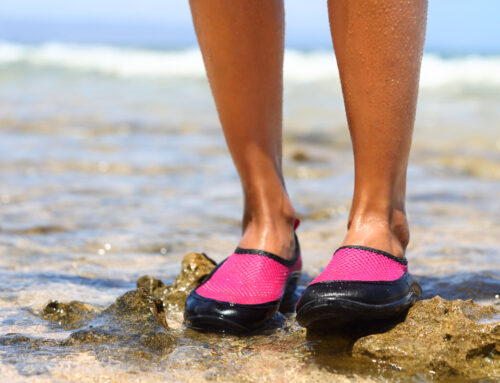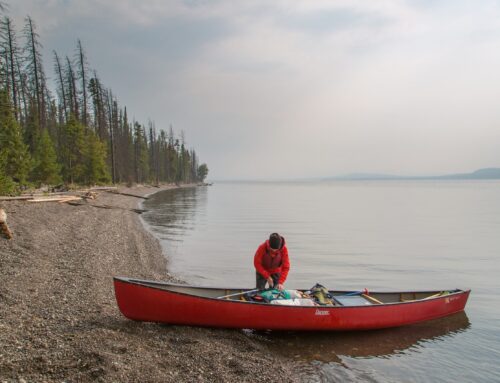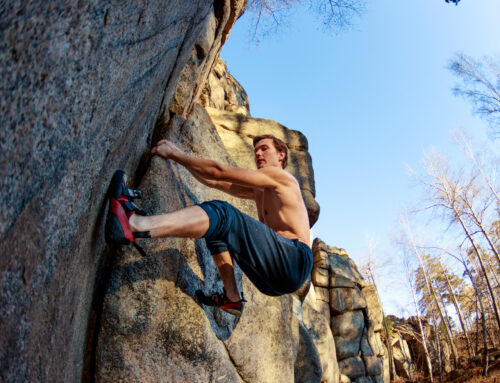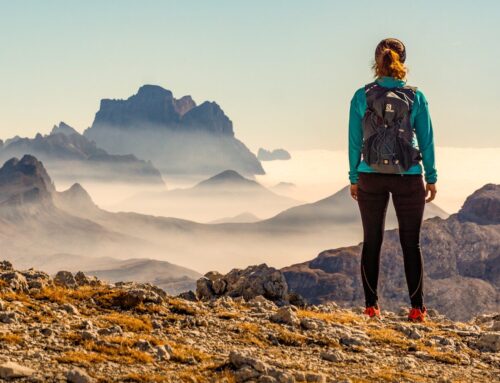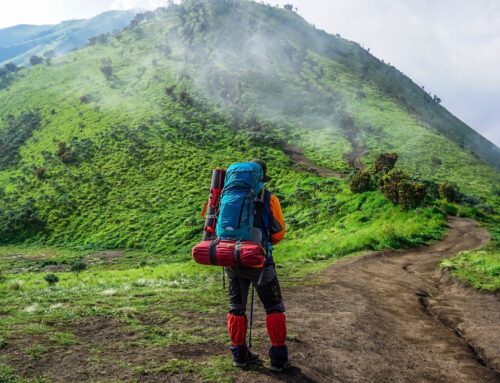Updated July 17, 2023
If you’ve ever bought a pair of climbing shoes, you’ve probably seen several models with women’s specific versions. It’s true – in recent years, most climbing shoe brands have developed women’s shoes with a design that’s meant to fit a woman’s foot better than the traditional men’s designs. After meticulously researching and testing several pairs of shoes, we created this guide to the best climbing shoes for women so you can find a pair that works for your needs and preferences.
Women’s Shoes vs. Men’s Shoes: What’s the Difference?
Recently, climbing shoe manufacturers have been putting out women’s versions of their most beloved models to better accommodate female climbers. Generally, women’s shoes are slightly narrower in build – especially in the heel and toe areas – and have slight design tweaks to fit a woman’s foot better.
Women’s climbing shoes typically have the following modifications from the men’s models:
- Narrower profile
- Lower ankle cut
- Extended toe box
- Tighter heel cup
- Higher arch
This works in theory, but in practice, you should always buy the shoes that fit your feet the best. Just because a pair of shoes is designated as “men’s” or “women’s” doesn’t necessarily mean you have to use one or the other. Plenty of women wear men’s climbing shoes and vice versa!
If you’re actively looking for a new pair of climbing shoes, we’d recommend trying on lots of different pairs – including women’s and men’s styles – to find the perfect pair for your comfort, experience level, and climbing style.
Best Climbing Shoes: Our Picks
La Sportiva Miura VS
Best Overall
- Materials: Leather upper; Vibram XS Edge rubber outsole
- Closure: Velcro
- MSRP: $185
- The Bottom Line: This durable climbing shoe is an all-around high performer indoors and outside
We don’t have enough good things to say about the La Sportiva Miura VS for intermediate to advanced climbers. While this isn’t technically a beginner bouldering shoe, it’s a reasonable step up for new climbers who are progressing quickly in their skill level and route difficulty. Designed to be suitable for indoor and outdoor climbing, the Miura VS boasts a stiff sole, durable leather uppers, and a performance-oriented downturned design. It’s also got excellent Vibram XS Edge soles for optimal stickiness on tiny footholds.
To be clear, this is not a beginner shoe. It’s targeted as a step up shoe for intermediate to advanced climbers with strong foundations in climbing. However, if your beginner climbing shoes are starting to hold you back from sending some more challenging routes, these could be a fantastic option for you.
Because of its superior build, the Miura VS is our absolute favorite climbing shoe for women for bouldering and roped climbing. If you’ve built up your skills and feel ready for a shoe to uplevel your climbing game, the Miura VS may just be the perfect companion for you.
La Sportiva Skwama
A Close Runner Up
- Materials: Leather upper; Vibram XS Grip2 outsole
- Closure: Velcro
- MSRP: $180
- The Bottom Line: Versatile women’s climbing shoes for technical indoor and outdoor routes
Our very close runner up for the best women’s climbing shoes is the La Sportiva Skwama, a solid contender for bouldering and trad climbing. As a suitable alternative to the La Sportiva Miura, the Skwama shines in its lightweight, slim fit and sensitivity for tricky footholds, smearing, and edging. As with many of La Sportiva’s high end models, quality and premium materials are the name of the game with the Skwama, and customers rave about this shoe for the gym and outdoors. A bit of a stiffer option than others on our list, these shoes shine when it comes to tiny footholds and technical footwork.
La Sportiva Solution
Best Women’s Bouldering Shoes
- Materials: Leather/synthetic uppers; Vibram XS Grip2 rubber outsole
- Closure: Velcro
- MSRP: $180
- The Bottom Line: Aggressiveness and sensitivity make the Solution one of the crown jewels of the bouldering shoe market
There are few shoes with a more fanatical, loyal customer base than the La Sportiva Solution. As one of the more aggressive shoes on the market, these ultra precise, sensitive shoes are a match made in heaven for climbers who enjoy bouldering in the gym or outside. Overhangs, tiny footholds, edging, and smearing are a breeze with this highly technical shoe, and the Vibram XS soles add even more stickiness and grip to their already incredible construction.
With this level of aggressiveness and downturn comes a certain level of discomfort, so don’t be surprised if the break in period for these shoes is a bit…intense. Couple that with sizing down for ultimate precision on the bouldering crags and it could take a decent bit of time before these shoes reach a tolerable level of comfort. But once you’ve gotten them to fit your feet, they might just become your bouldering BFFs.
Scarpa Veloce
Best Women’s Shoes for Indoor Climbing
- Materials: Synthetic upper; proprietary S-72 rubber outsole
- Closure: Velcro
- MSRP: $159
- In A Nutshell: Excellent intermediate step-up shoe for indoor bouldering and a solid vegan option as well
A strong contender for the best step-up bouldering shoe, the Scarpa Veloce is a seriously incredible design feat. This moderate shoe boasts high-quality synthetic uppers, a convenient velcro closure, and a soft, flexible build perfect for indoor climbing. In fact, the Veloce was designed and built specifically for indoor use, and because of this, you’ll find it’s a more comfortable alternative than the stiff, outdoor-focused La Sportiva Miura VS. If you primarily climb indoors, we’d recommend choosing the Veloce over the Miura VS.
La Sportiva Tarantulace
Best Climbing Shoes for Beginners
- Materials: Leather upper; FriXion rubber outsole
- Closure: Laces
- MSRP: $85
- In A Nutshell: Affordable, durable, comfortable option for those starting off in climbing
Take one look around the climbing gym and you’ll probably spot a handful of folks sporting La Sportiva’s Tarantulace shoes. It’s no surprise that this beginner-friendly shoe is so popular – it’s high-quality, comfortable, and affordable, the perfect combination for those wanting to dip their toes (pun intended) into the world of bouldering.
Best for gyms and beginner-level outdoor climbing, the La Sportiva Tarantulace is an ideal choice for those who are buying their very first pair of women’s climbing shoes. It’s built for comfort and wearability, avoiding the foot pain typically associated with more advanced shoe types. We’ve chosen the Tarantulace as our pick for the best beginner climbing shoes for women because they offer everything an early-stage climber needs at a great price.
What this model doesn’t offer is top-of-the-line materials (the FriXion sole, although durable, isn’t super sticky) or technical capabilities, which means you may find them difficult to use once you’ve reached a certain skill level. However, for those looking for an entry-level shoe that will support you in your early days while you learn critical climbing techniques, the La Sportiva Tarantulace is an exceptional choice.
Evolv Elektra
Best Bouldering Shoes for Beginners
- Materials: Leather upper; TRAX high-friction rubber outsole
- Closure: Lace or Velcro
- MSRP: $99 ($89 with velcro)
- In A Nutshell: Soft, comfortable, and flexible, these shoes are ideal for tackling short, tricky bouldering problems
Planning on dipping your toes in bouldering? The Evolv Elektra is our pick for the best beginner bouldering shoes on the market. Our founder loves these shoes so much, she uses them regularly at her own bouldering gym! With a soft, snug fit and grippy soles, these shoes are fantastic for those who are learning to boulder indoors or outside. Moreover, the extra flexibility in the sole will help you build foot strength and technique early-on.
We’ve chosen these shoes for bouldering because they’re super comfortable and well rounded. The TRAX rubber soles are excellent for learning smearing and working with tiny toe holds, and the upper offers one of the most comfortable climbing shoe fits we’ve encountered. Combined, these characteristics offer structure and stability for new boulderers who are just getting their footing in the sport.
While this is a fantastic shoe for beginners, the neutral aggressiveness and flexibility may eventually inhibit your growth as a climber down the road. However, as a first pair of bouldering shoes, we’d wholeheartedly recommend the Evolv Elektra.
Honorable Mentions
Scarpa Vapor V
- Materials: Synthetic microsuede upper; Vibram XS Grip 2 outsole
- Closure: Velcro
- MSRP: $195
- The Bottom Line: Great all-day women’s climbing shoe with a few small drawbacks
The Scarpa Vapor V is a crowd pleaser for more reasons than one. As one of the most popular climbing shoes for women, this intermediate to advanced model is perfect for indoor and outdoor climbing. Made from synthetic uppers and premium Vibram XS Grip soles, you know you’re getting Scarpa’s classic high-end construction and design paired with top-of-the-line materials.
There have been some customer concerns about fit and durability, and the break in period seems to be a bit longer and more painful than other competitive models. However, for the right climber in the right conditions, these shoes are worth considering for avid trad climbers, boulderers, or gym climbers wanting to step up from a beginner climbing shoe.
Evolv Kira
- Materials: Synthratek VX synthetic upper; TRAX SAS high-friction rubber outsole
- Closure: Velcro
- MSRP: $130
- In A Nutshell: A comfortable yet solid fully synthetic step-up shoe for folks who learn and progress quickly
As climbers, it’s always a bittersweet feeling when we outgrow our gear, and that can happen quickly when you’re spending a lot of time at the gym or on the crag. Luckily, the Evolv Kira exists for people just like you, as their utility extends beyond the first few steps in bouldering or trad climbing. Unlike the Elektra, these shoes take on a more advanced, downturned build, which is advantageous for more difficult overhang climbs and technical routes.
With high-quality synthetic uppers, an easy-to-use velcro closure, and a grippy TRAX rubber sole, these have all the bells and whistles necessary for ambitious beginner climbers wanting shoes that won’t inhibit them. Moreover, these slightly downturned shoes are built for progression into the intermediate stages of climbing. However, they’re comfortable enough for beginners to feel confident early-on, as opposed to other more advanced models which can hurt quite a bit to wear.

What to Consider When Buying Women’s Climbing Shoes
Buying your first pair of climbing shoes can feel like a daunting task given the number of great options out there. A lot of the vocabulary used to discuss climbing shoe designs may feel foreign to you, and thanks okay! We’ll break down everything you need to know about shoe designs and fit in this section so you’ll have a basic foundation for what to look for and ask about when you’re ready to buy.
Skill Level
Your skill level will be one of the most important factors in helping you choose the best climbing shoes for women. Generally, beginner climbing shoes are flatter, wider, more comfortable, and less versatile than more advanced shoes. As you progress, you’ll likely want to opt for a more technical build, with a downturned sole, stiffer construction, and stickier soles for more traction on the crag. While shoes don’t make a climber, having a pair of shoes that’s not aligned with your skill level can hinder progression, so aim to use your shoes until they’re truly hindering your progress.
Gym vs. Outdoor Climbing
Whether you want to climb indoors or outdoors may affect the shoes you’ll want to consider. After all, conditions and mileage do vary when comparing gym climbing with outdoor climbing. While any pair of shoes will work for both mediums, some shoes will perform better at the gym while others shine outside.
Gym Climbing
For climbers who plan to primarily climb indoors, you’ll want to look for a shoe that’s comfortable and durable, as you’ll be logging more climbs more quickly than outdoors. True “beginner” shoes with a neutral aggressiveness, thick soles, and more comfortable features are best suited for indoor climbing. Additionally, you may want to consider a Velcro option for easy on-and-off access at the gym. Flexible, soft shoes are much more appropriate for indoor climbing because they’ll help you built foot strength and technique early in your climbing journey. Those planning to do roped climbs may want to offer for a slightly stiffer shoe, though, as too much flexibility can cause fatigue earlier in a long route.
Outdoor Climbing
Outdoor climbing generally requires a bit more precision and technique than indoor climbing, and this is where a bit of downturn and stiffer soles can be more useful. Footholds can be small and much more daunting, and having a pair of shoes that can support you in tricky situations can provide confidence and security. While you’ll probably end up climbing in the gym before heading outdoors, if your endgame is to get out in fresh air, it’s wise to consider a more technical pair of shoes early-on.

Comfort & Fit
You could own the best pair of climbing shoes in the world, but if they don’t fit you or aren’t comfortable, they won’t help you climb better. The only way to truly know whether or not a shoe is a good fit for you is to try it on. You’ve got a couple of options here: either go into a local retail shop or climbing gym and try on different pairs of shoes, or order several pairs and then return the ones that don’t fit well. Typically, you’ll want to order your own street shoe size and then size up by half-sizes from there.
Upper Materials
The “uppers,” or foot-facing materials, are a critical component of any beginner climbing shoes. You’ll find different types of upper materials on our list, namely leather/suede, synthetic, and knit uppers. What you choose for your first pair of shoes comes largely down to preference. Essentially, there are arguments for and against different types of upper materials for a shoe.
Leather and Suede
Leather and suede uppers will stretch and conform to your feet over time, but typically require a break-in period to get to that point. These are the most durable shoes, and you’ll find that the vast majority of high-end climbing shoes are made of leather uppers. Many climbers find leather uppers to be the most comfortable as well. Leather is generally our choice when it comes to buying any climbing shoes, but for beginners, this isn’t quite as important, since you’ll probably upgrade your shoes before it matters in a significant way.
Synthetic and Knit
Synthetic uppers are a vegan-friendly choice and generally do not stretch, making them a great plug-and-play option. You won’t have as much of a break-in time or an adjustment period with synthetic shoes. However, they are typically less durable over time and often develop a stink to them that’s less prevalent in leather shoes. Evolv’s Defy/Elektra and Kronos/Kira all have synthetic uppers and they’re some of our favorite choices for beginner climbing shoes.
Knit uppers, like those found in the Black Diamond Momentum, are the most breathable choice, but are the least durable of all. These aren’t very common but you may see them from time to time – we’d generally recommend synthetic or leather uppers before knit ones.
Outsole Materials
We’re going to go out on a limb here and say that, in our opinion, the type of rubber on the sole doesn’t matter as much as the thickness of the rubber. What I mean to say with this is that there are certain types of rubber – Vibram’s XS Edge being a prime example – that are known for maximum grip, while others – like FriXion – which are less sticky but last longer.
For gym climbers, opting for a thicker sole is key because you’ll typically burn through more routes, more quickly indoors. Outdoor climbing can be a little more nuanced, as you’ll climb less but face grittier conditions in your shoes. In general, we’d shoot for anything 3.5mm and up, and if you can snag a shoe with Vibram rubber, you’ll have an easier time hooking, smearing, and edging on smaller holds and tougher routes.

Construction & Design
Closure: Laces vs. Velcro
So you’ve chosen a shoe with a robust sole and a durable upper. Now what? You’ll have to decide on a closure. There are three types of closures you’ll see on climbing shoes – velcro, shoelaces (lace), and slip ons. We don’t usually recommend slip ons because their fit can’t be adjusted like Velcro or lace closures can. But Velcro and laces have their own benefits, and many climbers tend to prefer one style over the other.
For fine-tuned comfort and performance, laces are the way to go. Laces are a lot more precise than velcro, and can be adjusted based on your personal preferences. Additionally, they can compensate for areas of the shoe that may be tighter or looser based on your unique foot shape. However, they are less efficient, taking more time to put your shoes on and take them off. Outdoor climbers generally prefer laces because they’re more streamlined than Velcro.
Velcro, on the other hand, is the mothership of convenience. You can take your shoes off and put them back on with ease, which is especially helpful during the break-in period when your feet are starting to hurt. Moreover, they require less time and effort to adjust, although can be more limited in customization by the closure design. Velcro also wears out over time and can be less durable than laces in certain situations.
If you look carefully, you’ll notice that a lot of shoes have Velcro and lace versions, so you can have your pick depending on your personal preferences.
Downturn/Aggressiveness
As a beginner, you’ll generally want a flat/neutral or slightly downturned shoe. Your shoes should not look like bananas as a first-time climber. Most climbers start off with a completely neutral shoe, then opt for more downturn/aggressiveness over time. Some climbers who plan to climb often and progress quickly may choose a slightly downturned option, like the Evolv Kronos/Kira or the Scarpa Helix, to start so they can progress without having to upgrade. Either way, don’t get ahead of yourself by choosing a super aggressive shoe to start with – it’ll only cause your foot more pain than necessary and hinder your learning and development.
Softness
The final characteristic you may hear about is “softness.” Shoe softness refers to how bendy or flexible the shoe is, versus solid and rigid. In general, we’d recommend a softer shoe for learning to climb because it will help you strengthen your foot muscles and build technique without relying on your shoes completely. For bouldering and gym climbing, a soft shoe can be especially helpful and versatile. Longer routes may require a more rigid shoe for stability and support.
Price
While we try our best not to take price into account when evaluating shoes, we know it’s an important factor for most climbers. Generally, you get what you pay for with climbing shoes, but that’s not the case 100% of the time. Always opt for shoes within your budget or consider buying a pair of lightly used climbing shoes if you’re new to the sport and want to save some money early on.
Additional Resources
- What to Wear Climbing: The Complete Guide
- Best Beginner Climbing Shoes









